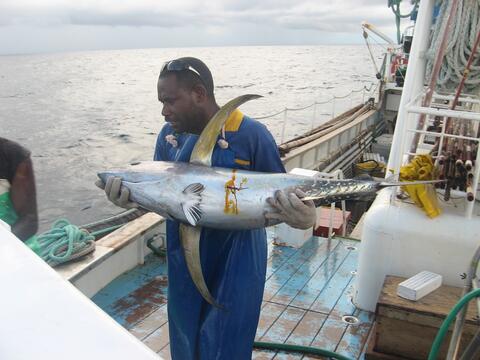Collecting information critical to the assessment of tuna species in the Western and Central Pacific Ocean and to understanding their ecology
Understanding the status and population movements of the regional tropical tuna stocks is vital for better management of this valuable resource. Tagging studies are commonly used in fisheries research to improve the estimation of animal population size, mortality, movement (spatial stock structure), and growth. The general objective of these studies is to establish an “experimental” sub-population of individuals tagged with numbered tags that can then be monitored and modelled over time through recaptures by the fishery.
In the Western and Central Pacific Ocean (WCPO) mark-recapture experiments have been an integral part of monitoring tuna stocks since the late 1970s. The data from tagging campaigns has been included in stock assessments since the 1980s and in integrated analyses since the late 1990s. Tagging experiments have become part of the ongoing work of the Western and Central Pacific Fisheries Commission (WCPFC) and have been implemented annually since 2006 under the banner of the Pacific Tuna Tagging Programme (PTTP). The PTTP has tagged close to half a million tunas across the region to help monitor the health of the world’s largest tuna fishery. This huge effort helps keep regional tropical tuna stocks in a healthy and sustainable state, for the benefit of all Pacific Island nations and the other members of the WCPFC.
Challenges for the tagging programme
Fish health
All tropical tuna species are extremely active and must constantly be swimming to avoid oxygen deprivation. A captured fish immediately builds up lactic acid in its blood, leading to irreversible damage if it is out of the water for too long. Catching and releasing fish must be done with minimal stress and injury to optimise their survival. This is why releasing a large number (multiple hundreds per day) of conventional tagged tuna implies the use of a pole-and-line vessel because tunas can be quickly and safely captured individually, tagged, and released in less than 15 seconds on average.

Vessels and logistics
The distances that need to be covered to dispatch the tag releases across the industrial tuna fishing grounds are huge, given that the WCPO region covers an area that is nearly 20% of the Earth’s surface. At the same time boat access to small island countries is often restricted to low draft hulls. These constraints imply the use of specific platforms which are not commonly available. The pole and line fishing method requires constant baitfish supply. This resource is not equally accessible across the Pacific region and if suitable baitfish species could easily be captured in ample quantities in the high productive islands of Papua New Guinea or Solomon Islands, this is not the case for atoll countries like Marshall Islands or Kiribati. Alternative fishing methods have been developed to tag fish in these areas using multi-purpose vessels to accommodate various fishing gears including long-line, short troll lines, rods and reels etc.
Regional collaboration and local knowledge
The implementation of tuna tagging experiments within SPC member country waters requires the delivery of research permits and a tight collaboration with the in-country fishery departments. Awareness of the traditional owners of the areas the vessel has to visit to collect the baitfish is necessary as permission needs to be agreed. Knowledge of indigenous customs and language means that onboard collaboration of local people is vital to the campaign's success, as well as providing a good opportunity for tuna research training.
Communication and publicity are essential
Cruise reports, tagging stories and scientific publications are produced very regularly and are essential to spread the information collected during the research experiments. Publicity is also a key element of any tagging programme success as it has a direct impact on the tag recovery reporting rate.
